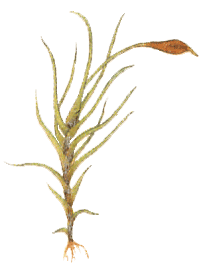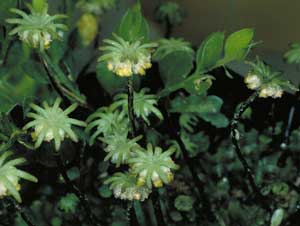
Bryogeography
What governs species' distributions ?
Factors such as soil or rock type, rainfall pattern, humidity levels, temperature ranges and plant community composition help determine which bryophytes will be found in a given area. These factors are acting now to define different bryophyte habitats and have acted similarly in the past. There are additional factors which have acted in the past to help produce current bryophyte distributions.
Bryophytes have been in existence for several hundred million years and so have been carried about on tectonic plates during the break-up of super-continents such as Laurasia and Gondwana. The latter (composed of Australasia, South America, Antarctica, India and Africa) is naturally highly relevant to any account of Australian bryophytes and many of the bryophytes of the Holantarctic Kingdom have a Gondwanan ancestry. As well as continental splits there have been joins. For example, South America collided with North America and, about 15 million years ago, the tectonic plate on which Australia was (and still is) moving north struck the Asian plate. After such collisions there would be easier migration of species between areas that head been isolated for eons. So, for example, species could move between the Americas or between Australia and the tropical Asian area of the Paleotropical Kingdom.
The earth has seen many ice ages. Extensive glaciation is likely to exterminate many bryophyte communities, undoubtedly breaking up some once-continuous distributions into separated colonies. Climate change that comes with an ice age would favour some species over others and so induce further changes in distribution patterns. Lower sea levels during ice ages create land-bridges that allow the migration of organisms where previously there was an impassable sea. Land-bridges allow the passage of numerous individuals (of any given species) so the colonists of a new area can display considerable genetic diversity. Furthermore, land-bridges allow many species to migrate concurrently so that whole plant communities can spread together. Climate change and rising sea levels at the end of an ice age would again see major changes. Bryophytes in many low-lying areas would be flooded and die. So, once again, what had been an unbroken expanse of bryophytes may be broken into a number of isolated populations, between which the transfer of sperm, spores and vegetative propagules becomes impossible. The different populations would then evolve independently and, given time, could develop into different species. With any change in climate there will be species which can no longer occupy much of their previous range because, overall, it has become too dry, or too cold, or too hot or....the list could go on. However some species may still survive in what seem unsuitable areas – as long as there are niches with the appropriate conditions. Some bryophytes, normally thought of as arctic or sub-arctic species are found in the tropics – but only on high, cold, alpine peaks. What would normally be thought of as wet-forest to rainforest species occasionally turn up in sheltered ravines in arid areas. What we may be seeing is relict populations, left over from a time when temperatures were generally much colder or when conditions were much wetter.
At any time there may also be random, one-off founder events. In these just a few spores or vegetative propagules land in an area where the species in question does not already occur. Such a small number of propagules is very likely to show much less genetic variety than that found in the parent colony. Hence any resulting new colony would also show less genetic variety than the parent colony. Consider the situation where spores are wind-dispersed across the sea towards a small, distant island where the species in question does not already occur. Many of the spores are likely to miss the island by falling short or by being blown off-course. Of the spores that land on the island only a small number may be able to germinate and survive against the competition so we have a founder event. The question of long-distance dispersal turns up often in accounts of bryophyte dispersal and bryogeography. That's not surprising given that many bryophyte spores and some vegetative propagules are light enough to be carried long distances by wind. Birds and ocean currents also have been proposed as long-distance dispersal agents. There's no doubt that long-distance dispersal happens but proof demands more than just the ability of propagules to travel long distances. There's more about this in the LONG-DISTANCE DISPERSAL CASE STUDY .
A more recent form of inter-continental connection is international trade. Humans have always carried goods between places, and over the past few hundred years the extent of such trade has increased dramatically. As well as intentional cargo, humans have unintentionally carried various plants and animals around the world. In earlier centuries there was considerable, deliberate movement of live plants for various reasons. Coffee and rubber plants were moved out of their home ranges with a view to setting up plantations in other parts of the world. Breadfruit trees were taken from the Pacific to the Caribbean with the intention of using them as food for the African slaves who worked in the British colonies of the Caribbean. Numerous Australian plants were shipped to England to satisfy scientific curiosity or to supply horticultural novelties to English gardens. Whenever a potted plant was moved there was always the possibility that some bryophyte, perhaps on the soil in the pot or on the plant itself, went along as well, albeit unintentionally. The thallose liverworts Lunularia cruciata ![]() and some species of Marchantia are notorious glasshouse weeds which grow readily in watered and fertilized pots. This photo (right) shows a species of Marchantia growing in a pot with a vascular plant. Amongst the mosses Funaria hygrometrica
and some species of Marchantia are notorious glasshouse weeds which grow readily in watered and fertilized pots. This photo (right) shows a species of Marchantia growing in a pot with a vascular plant. Amongst the mosses Funaria hygrometrica ![]() is common in pots in Canberra nurseries as is Bryum argenteum. Moreover, it would also be possible for bryophyte spores or fragments to move between continents on non-plant trade items. There's more about this subject in the IMPORTS AND EXPORTS SECTION.
is common in pots in Canberra nurseries as is Bryum argenteum. Moreover, it would also be possible for bryophyte spores or fragments to move between continents on non-plant trade items. There's more about this subject in the IMPORTS AND EXPORTS SECTION.
![An Australian Government Initiative [logo]](/images/austgovt_brown_90px.gif)


